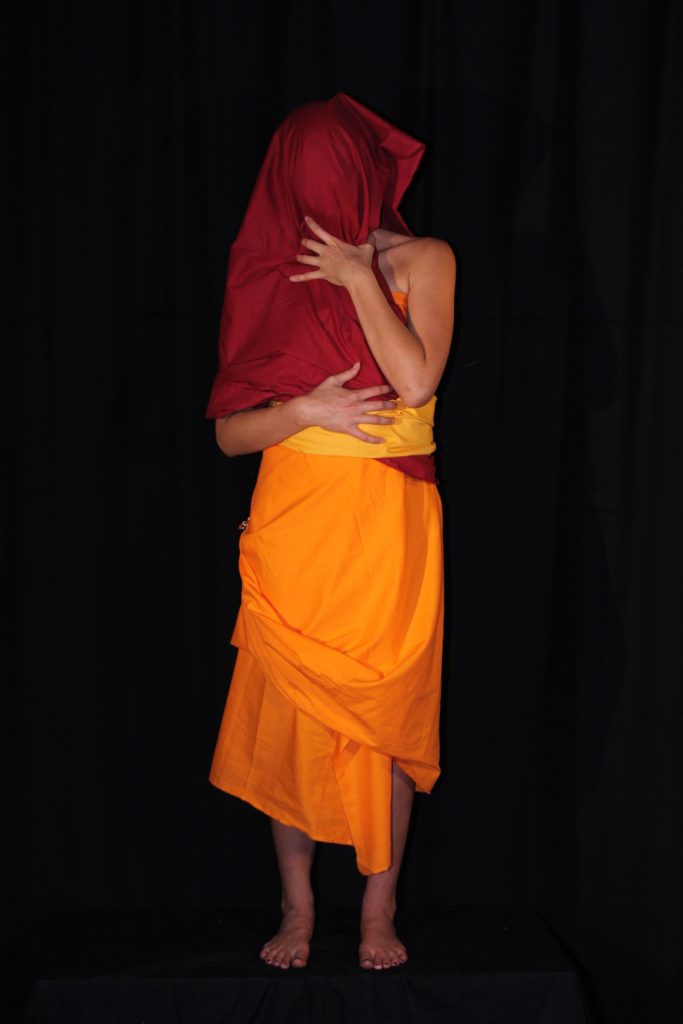Image credits: Images are by Amanda Scoville. Amanda is a senior at Eckerd College (Florida), where she majors in Religious Studies. She created the images as part of a final-year project for a course on Buddhism and sexuality.
Today’s post is different from the majority of Shiloh Project posts. Its focus is sexual abuse in Buddhist settings. In popular culture, Buddhism is associated with peace, tranquillity, gentleness and self-discipline. But rape culture manifests many forms and, including, it turns out, in some Buddhist settings.
The authors of this post are Amy Langenberg and Ann Gleig. Both are Florida-based scholars, currently working together on a book about sexual violations and US convert Buddhism. The book is under advance contract with Yale University Press.
In the first part of the post, Amy and Ann introduce their project, research aims, and methodology. In the second part, they share some of the challenges and pitfalls they have encountered. There is some inspiration and some good advice here for all who research, or wish to research, topics at the intersection of sexual violence and religion.
Centering Survivors? Methodological Reflections on Abuse, Sex, and the Sangha
In 2018, Andrea Winn, a former member of Shambhala Buddhist community, published three consecutive reports on the internet. Titled Buddhist Project Sunshine (BPS), these survivor-centered reports reveal an intergenerational pattern of sexual violence abuse. Shambhala’s founder, Chogyam Trungpa, was openly promiscuous until dying of an alcohol-related disease at the age of 48. His American dharma heir, Osel Tendzin, had unprotected sex with several of his students, knowing but not disclosing that he was HIV-positive. One student and his girlfriend later died of AIDS, as did Tendzin himself. Chogyam’s son, Sakyong Mipham, was forced to step down from his leadership position after the second BPS detailed incidents of sexual and physical abuse perpetrated by him. The trajectory of Shambhala illustrates one pattern of sexual misconduct and abuse in Western Buddhist convert communities since the 1980s. Cutting across Buddhist lineages, offenders have included many prominent first and second generation Asian and American teachers.
While there is a handful of popular books written by journalists, and a few autobiographical reflections by Buddhist practitioners directly involved, little academic work has focused on these cases. In our new collaborative book project—titled Abuse, Sex and the Sangha (under advance contract with Yale University Press) and funded by the Henry R. Luce Foundation—we hope to fill a gap. We pair ethnographic case studies of American Buddhist communities that have been the site of sexual abuse, with historical background on the Buddhist institutional, doctrinal, and ethical traditions that have influenced them. In developing this project, our original research questions focused first, on how Buddhists have interpreted these cases and second, on the new forms of Buddhist leadership, community and practices they have generated. We also have aimed to interrogate the authority and adequacy of classical and other premodern traditions for contemporary Buddhist communities in responding to scandal.
Our methodological orientation is rooted in the postcolonial feminist lineage of anthropology that advances ethnography as an act of identification, witnessing, and care. An early expression of this is Ruth Behar’s (1996) articulation of a “native anthropology” in which scholars claim a personal connection to their ethnographic sites and view identity rather than difference as key to research. Nancy Scheper-Hughes (2006) extends this identification with her anthropology of witnessing, in which fieldwork is intentionally undertaken as a radical act of empathy and protest. Yet more recently, in her work with sexual abuse survivors, Emma Louise Backe (2017) has called for an “ethnography of care” to be enacted towards both oneself and one’s interlocutors.
One very appealing expression of this feminist methodology is its collaborative nature: we share both the analytic and the affective labors of our research. Amy is a textual scholar whose expertise is in South Asian Buddhism, with a focus on monasticism, gender, sexuality, and the body. Ann is an ethnographer of convert American Buddhism with specialisation in issues relating to racial, gender, and sexual justice. On an analytic level, we want to bring together our disciplinary and methodological training and skillsets to give the project the depth it demands. On an affective level, we want to support each other in processing the intense emotional material we encounter in this project on sexual violence. At the level of ethics, we hold each other accountable while researching and writing about such a difficult subject.
Another expression of our feminist methodology is an emphasis on survivor voices. Drawing from intersectional feminism, a survivor centered approach is marked by “prioritizing the perspectives, needs and interests of survivors, and placing these at the center in developing and implementing interventions towards the eradication of gender-based violence.” While inspired by this approach, we have already encountered several obstacles with fully implementing such a model. We offer this reflection as a transparent work-in-progress that we hope might help other religious studies researchers also wanting to integrate survivor-centric perspectives.

Centering Survivors in Contemporary Ethnographies: Challenges & Opportunities
Our first misstep was one of research orientation.
We began the project with the following research questions: How have Buddhist institutions and ethical systems from Asia set the terms of sexual abuse in American Buddhist environments? How can we understand the complex religious and socio-cultural contexts that foster environments in which abuse can occur? What specific religious symbols, discourses, and practices are mobilized around sexual misconduct and the cultures of secrecy that enable it to occur? How do the psychological and affective realities of abuse interact with religious symbol systems and doctrinal concepts? What are the generative effects of the scandals: for instance, what new doctrinal and organizational forms of Buddhism are emerging from them?
In other words, our orienting questions were tradition- and community-centered, rather than survivor-centered. As we discovered, this focus on doctrine, community response, and on the impact on Buddhism, unintentionally but automatically moved survivors to a secondary position.
Our second misstep was that we began by privileging certain survivor voices over others. In our own research, we have come to see three broad categories of survivors:
(1) those who stay and want to be part of community reform;
(2) those who leave their community but continue to practice Buddhism;
(3) survivors who leave their community and tradition and feel that community reform is part of the problem in that it can involve attempts to pressurize and make survivors conform.
Because we have been working primarily on community responses, we come into more contact with and therefore privilege those survivors who stay in communities (1) or who remain Buddhists outside of the community where abuse took place (2). It is clear to us that for those survivors, narrating their experiences in the context of community and/or finding resources within the tradition form an essential part of their healing process.
What we have started to realize, however, is that other survivors (3) experience the pressure to be part of community reform as another form of violence and dishonesty. They report that Buddhist communities have weaponized doctrines in support of community cohesion rather than survivor-centered justice. Thus, we observe tensions as well as differences between survivors. And this raises new challenges: How do we negotiate between these differences in experience and outlook? How can we avoid centering one survivor narrative over another?
A third obstacle, less a misstep on our part than an inevitable feature of seeking to understand abuse, is that of survivor silence. In one of our case studies, Against the Stream, the women who made claims of sexual violence against Buddhist leader Noah Levine, have chosen to be anonymous. This means we have not been able to interview them. How can you center survivors in their absence? One way that we have negotiated this is to draw attention to their absent voices and the ways in which this allows community members to erase them.
Centering Survivors in Religious Studies: Challenges & Opportunities
We have also begun to wrestle with a deeper issue that is at play in the centering of survivor voices in Religious Studies and Buddhist Studies contexts. We have come to doubt that the issue of sexual abuse impact on survivors in Buddhism can be adequately addressed by Religious Studies methodologies alone. This is because survivor accounts tend to center doctrines, institutional histories, and the practices of those that stay in communities, but not the experiences of ex-practitioners that have permanently left religious communities. Indeed, cult studies, critical trauma studies, sociology, and social psychology may provide preferable frameworks than Religious Studies for adequately addressing the experiences of those survivors who, due to abuse, have chosen to sever ties with Buddhism.
In some ways, the subfield of Buddhist Studies is even less well equipped than Religious Studies for the task of centering survivors. The dominant core of the field continues to focus on the philological study of texts, and has tended to follow the intellectual contours of Asian Buddhist traditions in its emphasis on great thinkers and major doctrines. Although the field is rapidly changing, it has often neglected the experiences of those at the margins. Also, the voices and experiences of survivors can be difficult to locate in Buddhist textual traditions, especially in the absence of an explicit feminist hermeneutic.
For instance, texts about rape in the vinaya (the disciplinary traditions that guide monks and nuns) completely neglect the trauma of the raped person and focus instead on whether he or she can be deemed guilty of transgressing the rule ordaining celibacy. As an example, when the nun Uppalavaṇṇā is raped, monks wonder not whether she has been psychologically harmed, but whether, as a spiritually advanced being, she can still experience pleasure. Similarly, early treatments of sexual ethics for lay people tend to center the sexual obligations and rights of lay men, and leave aside the trauma of those women who are sexually violated or exchanged.
Feminist and postcolonial scholars of Buddhism have challenged readings that ignore the experience of the less powerful and the marginalized, such as those subjected to abuse within Buddhist institutions. This can involve locating and studying primary sources that were previously unknown to the Buddhist Studies community. For instance, Sarah Jacoby and Holly Gayley have translated autobiographical works by female teachers in Tibet that discuss their sometimes difficult relationships to male Buddhist teachers.
Amy’s work on reading against the grain in classical Indic sources also emphasizes the recovery of marginalized female voices, including the voices of those that have experienced sexual trauma. Amy’s new research for this project now includes reading classical sources constructively in order to recover ethical perspectives, doctrinal resources, and institutional procedures that are not typically brought forward by Buddhist ethicists, perhaps because they have not previously tackled the issue of sexual abuse, and certainly not from a survivor perspective.
Through our research process, we have come to realize that survivors have to be centered from the very beginning when designing a research project on abuse. This is all the more the case when contours of our fields and subfields invite us to do otherwise. Survivors so easily slip out of view unless placed at the center of inquiry. Survivor narratives are diverse, and we must be intentional about representing the plurality of survivor voices and careful not to inadvertently privilege one type over another. We have also come face to face with the challenges of how to make survivors, both past and present, visible and centered when we don’t have access to their first-person accounts, or when, for legal or ethical reasons, we cannot reproduce their first-person accounts.
It was only through conversation with survivors, other scholars, and stakeholders that we realized some of the limits of our methodological perspectives. This points to the importance of approaching this topic of abuse in religion collaboratively, and pursuing methodological humility, integrity and flexibility.
Published with support from the Henry R. Luce Foundation
Ann is Associate Professor of Religion and Cultural Studies at the University of Central Florida and author of American Dharma: Buddhism Beyond Modernity (Yale University Press, 2019).
Amy is Associate Professor of Religious Studies at Eckerd College and author of Birth in Buddhism: The Suffering Fetus and Female Freedom (Routledge, 2017).
For a recording of a lecture by Ann and Amy on the topic of this post, please see here. (The lecture was part of the seminar series of the Centre for Religion and Public Life, University of Leeds.)







Thank you for sharing
Well I never…I find academic language very hard to read. So much so that I spent many months re writing Rob Hogendoorn’s contributions to our joint authorship book Sex and Violence in Tibetan Buddhism..the rise and fall of Sogyal Rinpoche. Jorvik Press. I am surprised you didn’t reference it here. And equally pleasantly surprised that the academic community at long last appears to be getting to grips with this phenomenon. I have been bleating on about it since the mid 80s. Best wishes Mary Finnigan
mary.finnigan@gmail.co.m